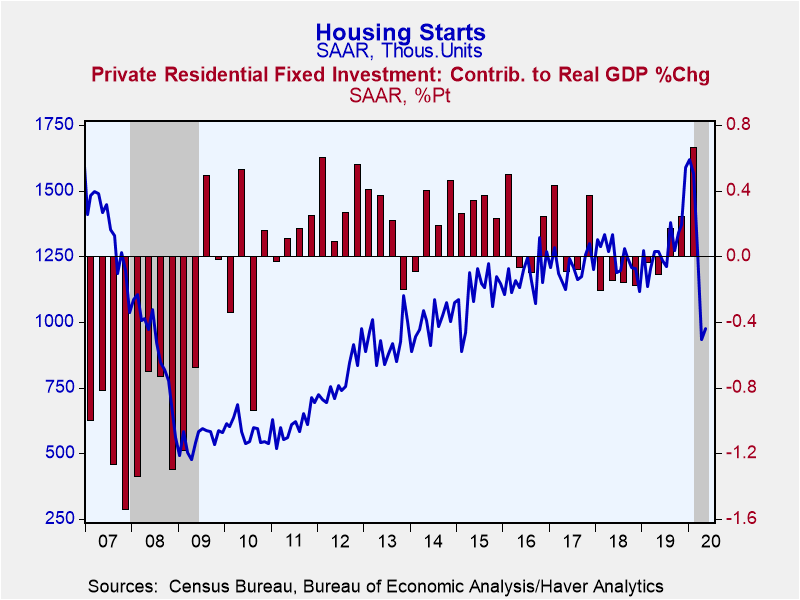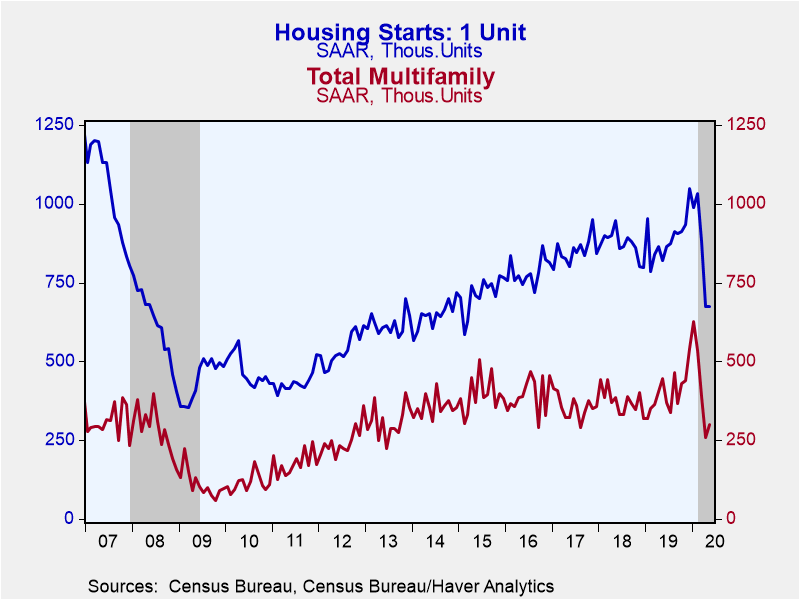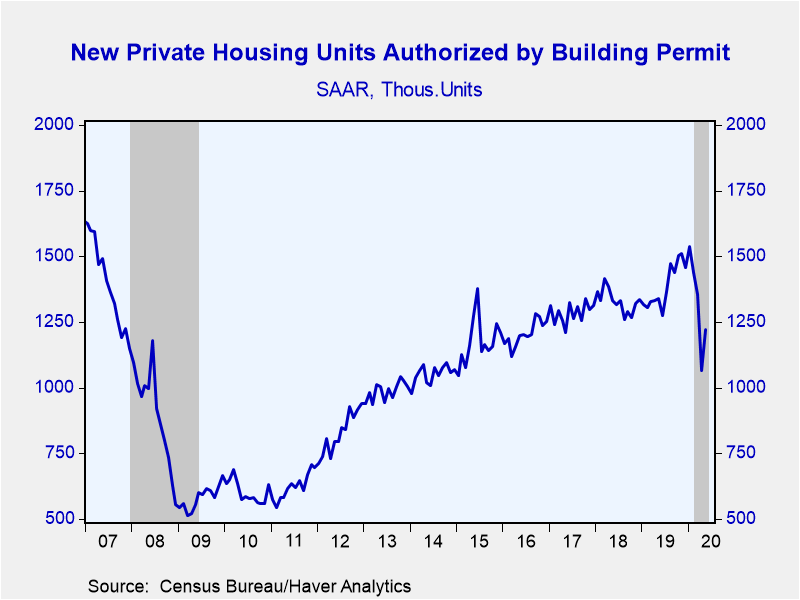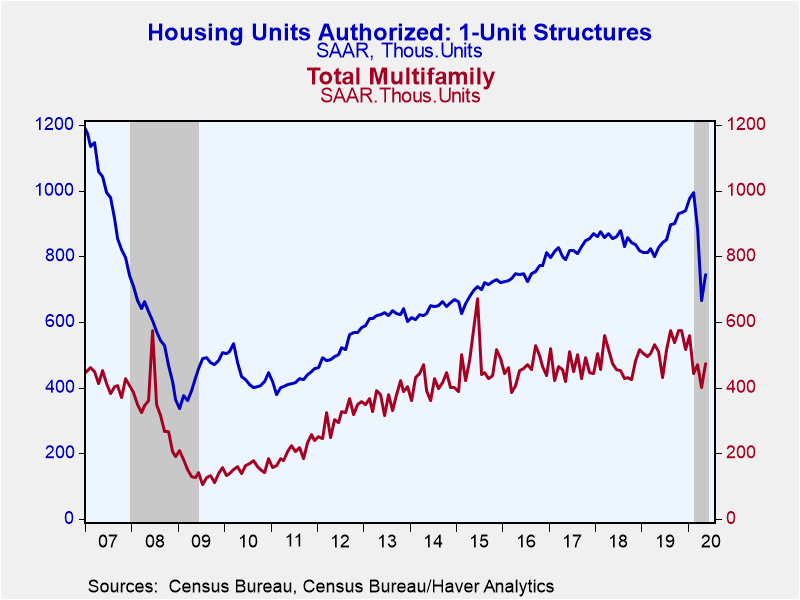 Global| Jun 17 2020
Global| Jun 17 2020U.S. Housing Starts Crept Upward in May
by:Tom Moeller
|in:Economy in Brief
Summary
• Home building still held back by coronavirus shutdowns last month. • Building permit increase suggests improvement is coming. New residential housing starts increased 4.3% during May (-23.2% y/y) to 974,000 (SAAR) from 934,000 in [...]
• Home building still held back by coronavirus shutdowns last month.
• Building permit increase suggests improvement is coming.
New residential housing starts increased 4.3% during May (-23.2% y/y) to 974,000 (SAAR) from 934,000 in April, revised from 891,000. Total starts remain 38.6% below their January peak. The Action Economics Forecast Survey expected 1.100 million starts in May.
Starts of single-family homes were little-changed last month (-17.8% y/y) at 675,000 following a 23.4% April weakening. It stayed near a five-year low. Multi-family starts improved 15.0% (-33.1% y/y) to 299,000, following three consecutive sharp monthly declines.
A 14.4% increase (-8.8% y/y) in building permits to 1.220 million units followed a 21.4% April decline. Permits to build single-family homes improved 11.9% (-9.9% y/y) to 745,000 after falling 24.7% in April. Permits to build multi-family homes rose 18.8% (-7.0% y/y) and recovered April's shortfall.
By region, last month's improvement in housing starts reflected a 12.8% increase (-39.1% y/y) in the Northeast to 53,000. It followed sharp declines in each of the prior three months and were three-quarters below January. Starts in the West increased 69.8% to 309,000 and y/y weakness remained modest at -1.9%. In the Midwest, housing starts fell 1.5% (-15.8% y/y) to 133,000 after declining sharply during the prior two months. In the South, starts decreased 16.0% (-32.3% y/y) to 479,000, off 44.9% in just the last three months.
The housing starts and permits figures can be found in Haver's USECON database. The expectations figure is contained in the AS1REPNA database.
U.S. Economic Outlook and Monetary Policy from Fed Vice Chair Richard H. Clarida can be found here.
| Housing Starts (000s, SAAR) | May | Apr | Mar | May Y/Y % | 2019 | 2018 | 2017 |
|---|---|---|---|---|---|---|---|
| Total | 974 | 934 | 1,269 | -23.2 | 1,298 | 1,250 | 1,209 |
| Single-Family | 675 | 674 | 880 | -17.8 | 894 | 873 | 852 |
| Multi-Family | 299 | 260 | 389 | -33.1 | 404 | 377 | 357 |
| Starts By Region | |||||||
| Northeast | 53 | 47 | 84 | -39.1 | 116 | 111 | 111 |
| Midwest | 133 | 135 | 162 | -15.8 | 170 | 171 | 181 |
| South | 479 | 570 | 705 | -32.3 | 689 | 631 | 603 |
| West | 309 | 182 | 318 | -1.9 | 322 | 337 | 314 |
| Building Permits | 1,220 | 1,066 | 1,356 | -8.8 | 1,350 | 1,330 | 1,286 |
Tom Moeller
AuthorMore in Author Profile »Prior to joining Haver Analytics in 2000, Mr. Moeller worked as the Economist at Chancellor Capital Management from 1985 to 1999. There, he developed comprehensive economic forecasts and interpreted economic data for equity and fixed income portfolio managers. Also at Chancellor, Mr. Moeller worked as an equity analyst and was responsible for researching and rating companies in the economically sensitive automobile and housing industries for investment in Chancellor’s equity portfolio. Prior to joining Chancellor, Mr. Moeller was an Economist at Citibank from 1979 to 1984. He also analyzed pricing behavior in the metals industry for the Council on Wage and Price Stability in Washington, D.C. In 1999, Mr. Moeller received the award for most accurate forecast from the Forecasters' Club of New York. From 1990 to 1992 he was President of the New York Association for Business Economists. Mr. Moeller earned an M.B.A. in Finance from Fordham University, where he graduated in 1987. He holds a Bachelor of Arts in Economics from George Washington University.










